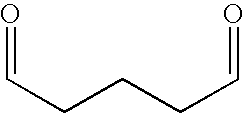Methods to control bacterial growth in fermentation processes
a technology of fermentation process and bacterial growth, which is applied in the field of methods to control bacterial growth in fermentation process, can solve the problems of reducing the fermentative yield, adding to the time, cost and/or convenience of producing ethanol, and yeast level, and achieves the effect of effective fermentation and increasing conversion
- Summary
- Abstract
- Description
- Claims
- Application Information
AI Technical Summary
Benefits of technology
Problems solved by technology
Method used
Image
Examples
example
Comparative Example 1
[0030]A comparison is done to show the effect of the use of three different materials exhibiting biocidal activity on both bacteria and yeast levels level in various media and at various points in time, compared to the effect of adding UCARCIDE™ 250, which is glutaraldehyde. SDA medium is synthetic defined agar, and PCA medium is plate count agar. Dow Antimicrobial™ 7287 is a composition containing 20 percent 2,2-dibromo-3-nitrilopropionamide (DBNPA), sold by The Dow Chemical Company. The results are shown in Table 3.
TABLE 3BiocideYeastBacteriaBacteriaconcentrationlevel1level2Yeast level3level4Biocide(ppm)(cfu / ml)*(cfu / ml)(cfu / ml)(cfu / ml)UCARCIDE ™ 250505.0 × 1045.0 × 105Diethyl Carbamate**504 2.6 × 107Dow Antimicrobial5508.0 × 1044.0 × 1057287 ™Control**02.0 × 1048.4 × 1071.2 × 1043.3 × 108*cfu / ml is colony forming units per milliliter**indicates not an example of the invention1denotes SDA medium2denotes PCA medium3denotes SDA medium, 2 hours after contact4den...
PUM
 Login to View More
Login to View More Abstract
Description
Claims
Application Information
 Login to View More
Login to View More - R&D
- Intellectual Property
- Life Sciences
- Materials
- Tech Scout
- Unparalleled Data Quality
- Higher Quality Content
- 60% Fewer Hallucinations
Browse by: Latest US Patents, China's latest patents, Technical Efficacy Thesaurus, Application Domain, Technology Topic, Popular Technical Reports.
© 2025 PatSnap. All rights reserved.Legal|Privacy policy|Modern Slavery Act Transparency Statement|Sitemap|About US| Contact US: help@patsnap.com

